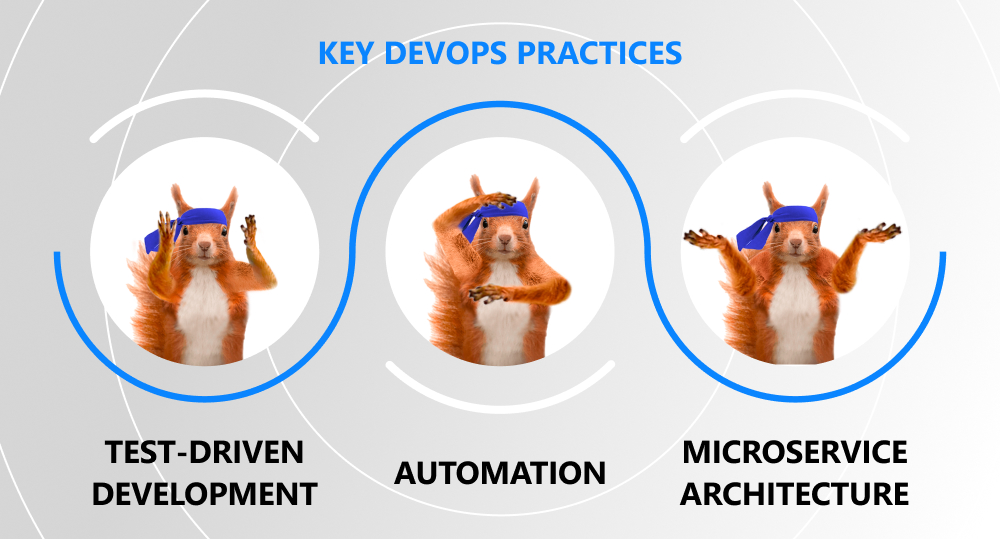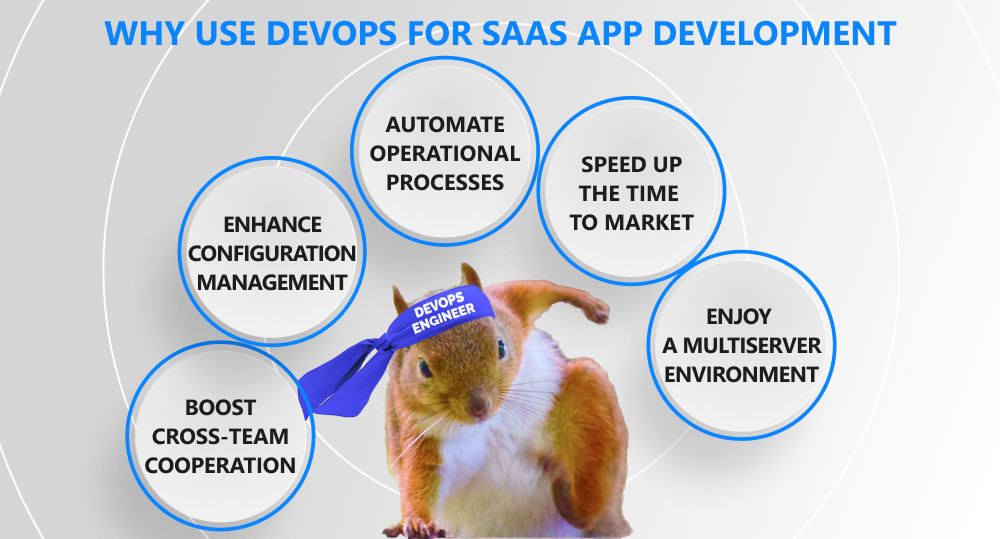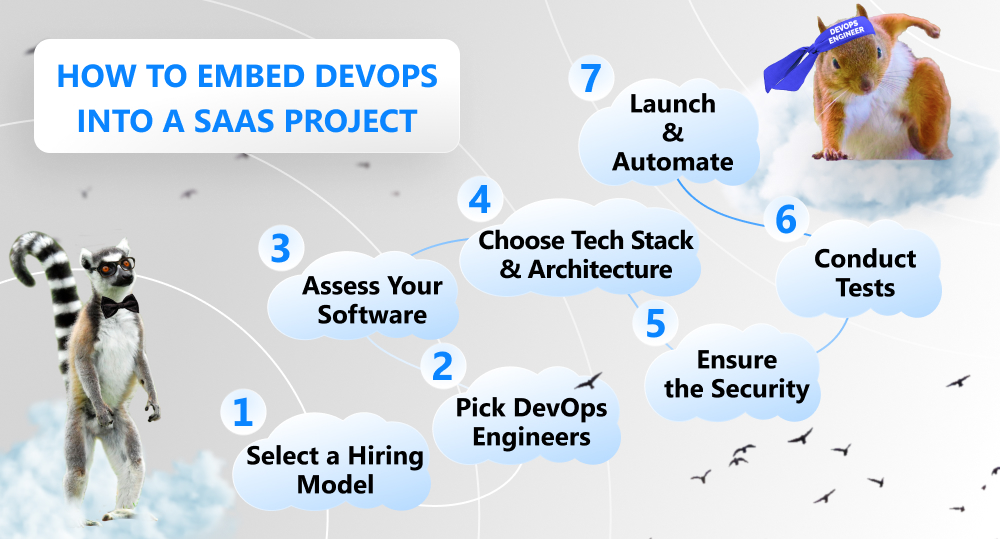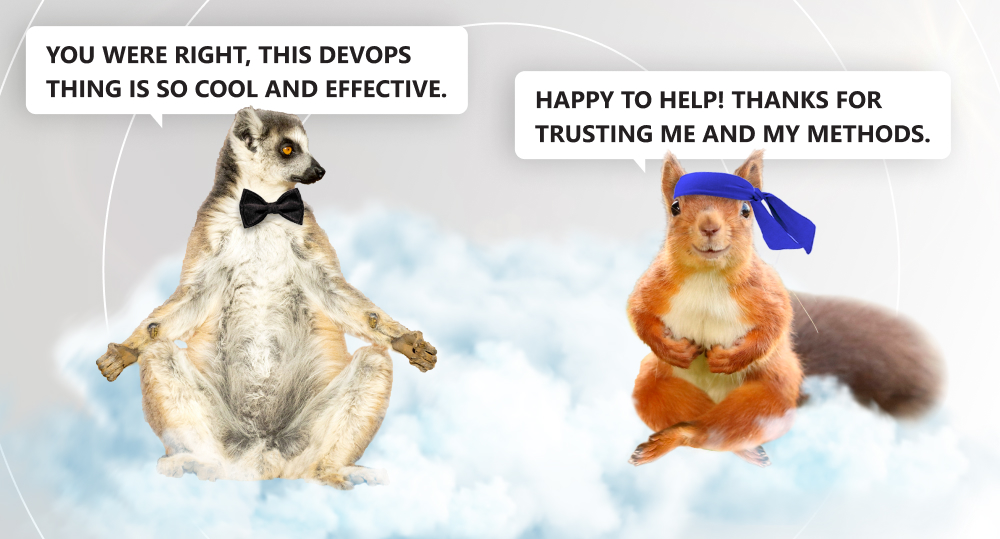Planning to use DevOps for SaaS applications and don't know how to get started? Stop panicking, as you've come to the right page, buddy. The DevOps approach is a real life-saver for dead-alive workflows and overloaded servers. And here, not only do we unleash its most essential concepts but also share with you expert-level insights about the DevOps SaaS platform and a step-by-step guide on a project enhancement.
Make yourself comfortable, scroll down a bit, and enjoy your reading!
written by:
Stanislav Makarovets
DevOps Engineer
Planning to use DevOps for SaaS applications and don't know how to get started? Stop panicking, as you've come to the right page, buddy. The DevOps approach is a real life-saver for dead-alive workflows and overloaded servers. And here, not only do we unleash its most essential concepts but also share with you expert-level insights about the DevOps SaaS platform and a step-by-step guide on a project enhancement.
Contents
Brief Guide to DevOps
Before we discuss how to employ DevOps for a SaaS project, let's explore the basics of this methodology and find out why the global DevOps market is forecasted to reach $30 billion by 2028.
A Bit of History
Long ago, when working on complex, large-scale projects, IT specialists followed a linear approach (a.k.a. the waterfall methodology). Since software developers moved to the next stage only after finishing the previous one, the product was updated once in several months or years, which was pretty inefficient and insecure.
In the early 2000s, a significant shift occurred with the introduction of the Agile methodology. Its innovative approach prompted engineers to reevaluate their process with a fresh outlook. Emphasizing the continuous integration of small code segments, regular updates, and the flexibility to adapt to changing requirements, Agile revolutionized the development landscape. These principles, outlined in the Agile manifesto, sparked a wave of game-changing practices within the industry.
Although Agile unlocked tangible benefits for IT teams and software owners, certain issues remained unresolved. Development and operations teams still worked separately by turns, which thwarted software delivery.
In 2007, tech communities raised concerns about the situation, and in 2009, Patrick Debois introduced the concept of DevOps (a portmanteau word from “development” and “operations”). This methodology allowed software companies to eliminate silos between separate teams, as well as create the conditions for continuous delivery and infrastructure automation.
DevOps Components
The DevOps paradigm is not just about the change in the software development procedure, but also about a significant cultural shift. A result-oriented DevOps strategy places its focus on cross-team collaboration, effective communication, and equal responsibility, and encompasses the following components:
- Configuration management;
- CI/CD framework;
- Infrastructure-as-a-Code;
- Product stability;
- Enhanced security.
Best DevOps Practices
To reach exceptional outcomes and fuel business transformation, DevOps specialists apply a wide set of practices.
Test-Driven Development
To boost complex tasks and reduce errors that occur during each software release, a DevOps team first launches automated tests and then gets down to writing the actual code, shortening and enhancing each development cycle.
Microservice Architecture
When integrating DevOps into the project, you may also take advantage of a flexible, service-oriented microservice architecture. Unlike its cumbersome monolithic counterpart, the microservices approach eliminates downtime and boosts product scalability.
DevOps Automation
One of the crucial ideas behind the DevOps solutions is the following: always automate tedious tasks that can be automated. That is why, if you let DevOps experts in your current project, not only will they optimize the software development lifecycle but also streamline manual repetitive tasks.
And if your inquisitive mind craves cold stats that prove the efficiency of the methodology, here they are: 61% of companies that switched to DevOps have already propelled their businesses to the next level.
5 Unbeatable Reasons to Enrich Your SaaS App with DevOps Practices
When launching an app powered by cloud technologies, SaaS entrepreneurs expect accelerated code delivery, boosted customer satisfaction, and great scalability. Still, for several reasons, most cloud development projects reach a deadlock at a certain stage. The good news is that you may easily reenter the game with quality DevOps consulting services and technologies.
Below, you'll find when it's time to leverage SaaS DevOps strategies.
Reason #1. Your Teams Fail to Cooperate Effectively
If your operations and software development teams face silos when working together, employing DevOps for SaaS solutions may be a perfect starting point. Since a DevOps engineer is a tech genius capable to bridge the gaps between several teams and streamline their work, SaaS companies may significantly benefit from timely DevOps implementation.
Reason #2. You Need to Enhance Configuration Management
Proper source control management is an integral part of SaaS application development. If the software engineers from your SaaS startup fail to provide ongoing version control and automate manual configuration processes, it's another red flag to make use of the DevOps strategy consulting services.
Reason #3. Certain Processes Require Automation
The right set of DevOps tools automates repetitive tasks and ensures continuous deployment. Therefore, if you want to optimize dead-alive processes and help your team effectively cope with the workload, using DevOps for SaaS app development will be a truly wise choice.
Reason#4. You Plan to Accelerate the Time to Market
Have you heard that 49% of companies have managed to boost the time to market thanks to embedded DevOps technologies? Such an outcome has become possible through frequent updates, enhanced testing, and reduced downtime. You may also reap these benefits after switching to the DevOps & SaaS strategy.
Reason #5. You Want to Switch to Several Load-Balanced App Servers
To ensure a seamless user experience and take advantage of responsive and multifunctional SaaS apps, you'd better create a multiserver environment. Such an infrastructure will allow you to distribute the load between several servers (each server will be responsible for a particular app functionality). Don't know how to implement a smooth transition? Hire a well-versed DevOps specialist and get the server nodes of your SaaS solution fine-tuned.
What Is a DevOps SaaS Platform?
An upscale DevOps SaaS platform is the one that is highly scalable, feature-rich, and never stops its evolution. It unites the most innovative practices of both approaches into one robust application that is frequently delivered over the internet.
Key DevOps SaaS Platform Features
Product Aspect
Features & Functions
Platform management
- Round-the-clock app management
- Scheduled upgrades
- Security patching
Compliance & security
- Single sign-on (SSO)
- Authorization
- Data encryption
- Key management system
DevOps tools
- CI/CD: Jenkins, CircleCI, GitLab, Docker, ArgoCD, Bamboo, Ansible, Puppet, Terraform, Kubernetes, Openshift
- Project management: Jira, Zendesk, Asana
- Monitoring: Prometheus, Grafana
- Logging: Elasticsearch, OpenSearch
Cloud tools
- AWS, IBM Cloud, GCP, Azure
Performance
- Disaster recovery
- Auto-scaling
- Instance resizing
Customer support
- Frequent operational reviews
- Round-the-clock service desk
How to Get Started with DevOps for SaaS Applications?
The launch of a DevOps SaaS platform is not as challenging as it may seem, provided you are armed with a well-trodden project strategy. As a trustworthy DevOps service provider with a vast number of successful cases under our belt, we are happy to share with you such a strategy.
Step#1. Select a Proper Engagement Model
For starters, you need to find DevOps for the SaaS project. To extend your team with a lacking expert, you may hire an in-house employee from scratch, take advantage of outsourcing DevOps services, or make use of the dedicated development model.
Although the first option allows you to enjoy the benefits of a fully-fledged in-house engineer, it requires huge resources for the hiring process. With a DevOps outsourcing company, you'll minimize operational costs and quickly get adept specialists (who may simultaneously work on other projects).
But we recommend you try a dedicated DevOps team model, as it will provide you with top-rated engineers at the most tempting price who will be completely involved in your SaaS product.
Step#2. Handpick Well-Versed DevOps Engineers
No matter what cooperation model you have chosen, the next step will be to compile a well-knit team that will answer all your requirements.
When selecting your future teammates, pay attention to their soft skills (teamwork, flexibility, time management, etc.) and the technology stack required for a SaaS solution (Datalog, New Relic, Segment.io, Twilio, etc.) and ask them industry-specific questions.
Step #3. Evaluate the Current State of Your Product
Once the team is gathered, it's high time to get down to work. To define a perfect project strategy, you need to assess the current state of your application and check whether it answers basic DevOps concepts.
Step #4. Choose the Project Roadmap and Architecture
After the upsides and bottlenecks of your software are scrutinized, the team of experts should pool its efforts around the project roadmap elaboration. This stage is a crucial one, as you need to decide on the tech stack and project architecture (whether it will be a multiserver or serverless microservice SaaS architecture). As soon as all parameters are predetermined, your team may plunge into the development process.
Step#5. Think Through the Security Mechanisms
A reliable security system is another challenge to keep in mind when building a DevOps & SaaS app. Still, with a highly-professional service provider, you have nothing to worry about. Just set your project requirements and enjoy a hacker-proof, future-focused solution.
Step #6. Conduct Thorough Testing
Once the first version is rolled out, it's time to test it in and out. After the developers fix all the bugs and enhance the security mechanisms in compliance with the test results, the software is ready for the next stage.
Step #7. Automate the Delivery and Enjoy a Scalable Solution
After software deployment, the DevOps engineers may roll up their sleeves and get down to delivery automation. The hallmark of an excellent outcome is the code that may be delivered by any team member with the press of a button.
Key Takeaways Before You Go
Before you leave this page, let's briefly systematize all the valuable insights in a plain and simple FAQ manner.
#1. What Is the Meaning of SaaS?
Software-as-a-Service (SaaS) is such a delivery model that allows users to access cloud-based solutions on a subscription basis. To reap the benefits of on-demand, web-hosted cloud services, all you need is a stable internet connection. Among the most well-known SaaS products, you may find Zoom, Netflix, Duolingo, Google Cloud Platform, and others.
#2. Does SaaS Involve Coding?
In the SaaS model, it's a cloud service provider who is responsible for server hosting and database maintenance, while your task is to build an intuitive web app and integrate it with the cloud. Therefore, you'll need skillful programmers on board your team for such a project.
At the same time, no-coding (low-coding) is gaining momentum today. This approach turns the software development process upside down, enabling people with minimal tech knowledge to build a future-focused SaaS application.
#3. What Type of Software Is DevOps?
DevOps software is a digital product built and launched in compliance with the DevOps methodology. It means, when creating the software, the operations and development teams worked in close collaboration to ensure the product's continuous delivery and infrastructure automation.
#4. Which Platform Is Used for DevOps?
Since DevOps practices target microservices and containerization, among the most popular DevOps platforms you may find Ansible (Red Hat), Chef, Puppet, and Terraform.
#5. What Is DevOps in SaaS?
The DevOps-powered SaaS model (a.k.a. SaaSOps) is a state-of-the-art approach to software development that brings the best of both the DevOps and SaaS worlds in a single robust solution. As a result, software owners boost the delivery and enhance the quality of their products.
#6. Is Azure DevOps SaaS?
Microsoft Azure is a feature-rich cloud computing platform that offers innovative services and a highly-scalable application environment for IaaS, PaaS, and SaaS projects.
#7. What Is the Difference Between SaaS and DevOps?
SaaS is a cloud-based approach to app server maintenance, while DevOps is the tech philosophy based on cross-team collaboration and automated product delivery. SaaS DevOps services, in their turn, unite these practices to enable software owners to speed up the delivery of infrastructure-ready solutions.
Got stuck in the middle of the development process trying to find out which of the SaaS DevOps strategies is your silver bullet? Contact us, and we'll get your software back on track.

Contacts
Feel free to get in touch with us! Use this contact form for an ASAP response.
Call us at +44 151 528 8015
E-mail us at request@qulix.com










